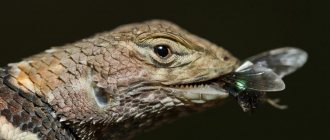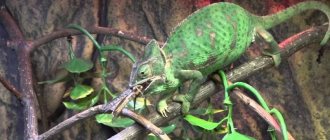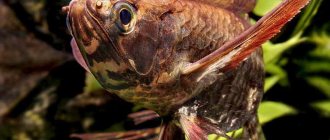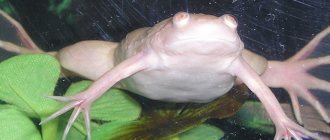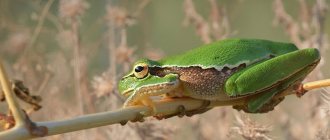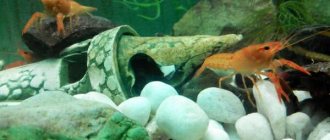While working in the garden, you can often stumble upon frogs unexpectedly jumping out of the green grass or important and clumsy toads barely crawling out. Many people are disgusted by these animals. Meanwhile, it should be remembered that there are benefits from frogs. They are tireless hunters of all kinds of small pests, bringing invaluable benefits.
The information in the article will allow you to take a closer look at the life activity of these animals, and perhaps many will even develop some sympathy for these interesting creatures.
Before we find out what a frog eats, let’s present its description.
General information about toads and frogs: differences
Toads and frogs are tailless amphibians that live in water and on land. Even when leaving the water, these animals are very dependent on it. In addition to pulmonary respiration, they also have active skin respiration, which allows amphibians to stay under water for a longer time. But dry air and prolonged exposure to the sun have a detrimental effect on them.
What does a frog eat? You can find out more about this below in the article.
Frogs and toads are closely related. The difference between them is that frogs have smoother skin, long strong hind legs with well-developed membranes between the toes. All this helps frogs to jump well and swim quickly. And the toad has dry skin covered with “warts”, their legs are weak and short, allowing them to move only by waddling or in short jumps. The membranes between the toes are not developed, which is why they swim poorly and spend less time in the water (in fact, only during the breeding season).
It is difficult to determine by its structure and appearance what the frog eats, but it can be guessed. It has a flat back and head, and its eyes often protrude above the water surface like bubbles of liquid, without revealing the animal itself. The hind paws are strong, like a spring, and the front paws, designed like palms, are grasping. The frog's jaws are studded with sharp, small teeth facing inward. The wide mouth contains a sticky tongue. By comparing all of the above external signs, we can guess what the frog eats - mostly small aquatic inhabitants.
Amphibian breathing
Amphibians breathe through their lungs and skin. The grass frog receives 33% of oxygen through its skin. The exchange of gases through the skin with the environment in amphibians occurs only through the water film, so the skin is constantly moistened with mucus produced by numerous glands. In the sun, the film on the skin dries out and prevents moisture loss.
For protection, toads have poisonous glands that secrete substances with a pungent odor, a very bitter taste, a burning and emetic effect. After all, they cannot move quickly and escape from the hunter. The venom of gray and green toads is not dangerous to humans, especially since it is released only under mechanical pressure.
Spadefoot, accidentally dug out of the ground
Spreading
This family (true frogs) belongs to the order of tailless amphibians. The composition of the latter is numerous, including 32 genera and about 400 species. Most of them are inhabitants of the jungle (humid tropics).
The largest of the tailless amphibians is the goliath frog (3 kilograms), which lives on the coast of the Republic of Cameroon in Africa. Quite recently, the smallest frog was discovered in New Guinea - the size of a little fingernail.
Central Russia is mainly inhabited by species of the gray and common toad. They are widespread in Russia to Sakhalin, as well as throughout Europe and Africa (northwest).
Most of these amphibians have a modest, inconspicuous color, but some can have quite bright colors, especially for poisonous species that live mostly in the tropics.
general characteristics
The frog family has a distinctive appearance, characterized by the absence of a distinct neck. As a result of this feature, the impression is formed that their head is one piece together with the body. Frogs were included in the order of tailless frogs due to the absence of a tail, which is also considered their characteristic difference.
Frogs have unique vision that allows them to control their entire environment within a 360-degree radius.
Amphibians have a fairly large, flat head, with convex eyes on the sides. Frogs have two pairs of eyelids - located below and above. Under the lower eyelid is the nictitating membrane, which is also called the “third eyelid.” At the back of the eye is the eardrum, which forms as an area hidden by thin skin. Amphibians also have a rather large mouth, above which two nostrils with natural valves are visible. Frogs have small teeth in their mouths.
The front legs of frogs are equipped with four small toes, which are shorter than the hind legs. The hind legs are more developed and end in five toes. Between them is placed a membrane formed from the skin, thanks to which the frogs feel good in the water.
Amphibians have no claws on their fingers, which is a distinctive feature of the family. In the back of the body there is a cloaca, through which processed food components are excreted. The frog's body itself is completely covered with bare skin, on which there is a special mucus secreted by the subcutaneous glands.
The size and weight of frogs directly depend on their variety. In general, their size is in the range of 0.8-32 cm. The African goliath frog is considered the largest. Its dimensions reach up to 50 cm and weigh several kilograms.
Some species of frogs do not have poisonous coloring, but are able to imitate it to protect themselves from potential enemies.
In addition to size, frogs also have a wide variety of colors. Amphibians are often distinguished by variegated body colors, which correspond to their natural habitat. The specific color allows them to camouflage among plants and herbs, remaining unnoticed by enemies.
Often the bright color becomes evidence of the poisonousness of the frog, which also scares away their natural enemies. Toxic substances are produced by glands located on the skin. Substances can be dangerous not only to other animals, but also to people.
The frog's original adaptation is considered to be its hearing aid, which allows it to adapt to living conditions in the border zone located between land and water. Frogs perceive sounds through three channels. In the air, sound waves are perceived by the cells of the inner ear, which show themselves to be the most sensitive. Sounds that travel on land are perceived by the bones and muscles of the paws and enter the inner ear through the cranial bones. Sounds in the aquatic environment are felt by the skin and enter the inner ear through the circulatory system.
Thus, frogs learned to cope with the difficult task of organizing the most comfortable conditions to adapt to complex living conditions located on the border of several environments.
Poll: Have you ever held a frog in your hands?
Yes, I did
71.43%
No, I didn't hold it
28.57%
Voted: 14
Species of frogs and toads
Before we find out what frogs eat in a pond, as well as in other natural and domestic conditions, we will consider the most common varieties of these amphibians. Their life (toads and frogs) is closely connected with water, however, there are species that, as adults, mainly live and hunt only on land.
In central Russia there are 4 species of frogs: lake, pond, grass, sharp-faced. The first two species are green in color, the second are closer to brown.
Among the inhabitants of Russian gardens, the most common are the sharp-faced and herbaceous. The first one has a protective coloration that allows it to be invisible on the ground, but it is much smaller in size than the grass one. The second has a gray-brown or brown back with spots of different colors, and its belly is mostly light with dark spots.
In addition to the grass frog, the Siberian frog also lives in the territories of Siberia. Its distinctive feature is pink spots on its brown belly.
Among toads, the most common are 2 types:
- ordinary, or gray, with a dark brown back;
- green, with large green spots on a light gray back.
Reproduction
Ornamental amphibians reach maturity after the first 2-3 years of life. For reproduction, it is necessary to equip a separate container with a water temperature two degrees higher than in the main tank. You can determine the readiness of pets to reproduce by the characteristic sounds that residents make.
Fertilization occurs at night: the male hugs the female, after which the couple turns over and returns to the standard position. The expectant mother then lays eggs, which are fertilized by the father. After laying out, the parents are removed from the container.
The eggs reach 1-2 mm in diameter, the number is 200-400 eggs. After a couple of days, the larvae hatch, and then the tadpoles. Babies are fed tubifex, ciliates and brine shrimp. After six weeks, the tadpoles transform into adults.
Nutritional Features
All types of frogs are tireless in obtaining food. What does a frog eat? It is known that the grass frog eats approximately 1,300 insects - pests of gardens and vegetable gardens - over the entire summer period. And the sharp-faced one exterminates many pests, including stink bugs and beetles, which even birds avoid.
As a rule, frogs forage for food during the day, and toads destroy pests mostly at night and at dusk.
Interesting Facts
What does a frog eat and how does it do it? They, like toads, are insectivorous animals. Frogs have teeth only on the upper jaw, and toads do not have them at all, so they have nothing to bite off pieces of food with. Due to these features, food is swallowed whole by frogs and toads. They catch their prey with the help of their original tongue - long, strong and forked at the end. It is thrown out of the mouth with lightning speed in the direction of the victim, and then, due to the fact that it is sticky, it returns back with the prey already stuck.
Another interesting fact is that food enters the esophagus thanks to the eyes. When blinking, the eyes plunge deeper, pushing food into the esophagus.
What do frogs eat in nature?
Toads have an excellent appetite. The main food for them are invertebrate animals: worms, insects, bedbugs, spiders, caterpillars, mollusks, etc. More than half (60%) of all insects eaten by the toad are agricultural pests. These animals also feed on slugs. Many gardeners observe unpleasant slugs on strawberries, which usually hide in the damp soil during the day, and in the evening come out to eat the soft, juicy fruits of sweet, ripe strawberries. It is very difficult to fight them. This is precisely where toads are excellent helpers.
The adult frog is a carnivore. The frog feeds on mosquitoes and other types of insects. For the lake fish fry are tasty prey. Due to this, considerable damage is caused to fish farms. Hiding in shallow water, the frog waits for a school of fry, and having waited for them, it sharply opens its mouth, into which a bunch of fish are drawn in by the flow of water. Tadpoles may also be in the mouths of the fry.
Plant remains are often present in the stomachs of frogs, because part of the leaves and flowers on which their prey sat sticks to their tongue. All this is quickly swallowed by the frog, after which it again goes for new food.
Where do they live?
Frogs are found on all continents except Antarctica, as well as on most oceanic islands. Amphibians have adapted to life in temperate and cold climates, although their greatest species diversity is represented in the tropics and subtropics.
Where live
At the initial stage of development, the habitat of frogs is fresh water bodies. Adults live on land near lakes and rivers, in forests with high levels of humidity, and in swampy areas.
What do frog tadpoles eat?
The larval stage of different species of frogs is very similar.
Tadpoles hatched from eggs do not have a mouth opening. The embryonic supply of nutrients ends after about seven days, when their length reaches 1.5 cm. During this period, the mouth breaks through and independent feeding begins.
The main food of tadpoles is single-celled algae. Random impurities that are absorbed by the frog’s body along with the main food are mold fungi, protozoan flagellates and other microorganisms.
The tadpole's mouthparts are well adapted for scraping off algae deposits and are shaped like a “beak” surrounded by fringed lips. The lower one has rough growths and is larger in size than the upper one. Tadpoles feed during the day, being in warm water in the shallows and off the coast, forming mass aggregations (up to 10,000 pieces). Not all of them survive, since the larvae of frogs serve as food for birds, fish and many other inhabitants of the reservoir.
The tadpoles turn into young frogs. They are quite gluttonous. When full, their stomach volume exceeds 1/5 of the total mass.
Another curious detail is that if there is not enough animal food in the reservoir, the tadpole overwinters in the larval stage, postponing its transformation into a predator until spring.
Compatibility
Frogs can be kept together with other underwater inhabitants: non-predatory turtles, calm medium-sized fish, shrimp. When placing several representatives of different species into one tank, the temperament and living conditions of the pets are taken into account in order to avoid sad consequences.
Amphibians demonstrate poor compatibility with small phenotypes, energetic fish and aggressive species.
Aquarium frogs
What do frogs eat at home?
The clawed frog is especially popular among aquarists, whose skin secretions have the effect of a natural antiseptic that disinfects water well. Such a frog is usually placed in an aquarium with fish that have some kind of infection. However, there must be a mesh partition between them, since the frog can eat its “patients”.
Typically, amphibians living in an aquarium feed on live food: earthworms, daphnia, bloodworms, etc. Due to the fact that frogs move little in captivity, they tend to become obese. They should be fed no more than 2 times a week. They can also eat thinly sliced lean meat or fish.
What do frog tadpoles eat at home? In the very first days, powdered milk is suitable for them (baby formula is also good). In the second week, you can introduce a mixture of insects and herbs into the diet after a good steaming in the oven or in the sun to avoid various putrefactive processes.
Beef liver and small bloodworms are introduced in the last days of metamorphosis to strengthen the body of small frogs, but all this should be crushed to the smallest size.
Content
Keeping frogs in a home artificial pond does not require much time and effort from the owner. Frogs are not demanding of cleanliness and order, so water is rarely replaced, using settled liquid for renewal. The recommended temperature is 22-26C; at lower degrees the pets will get sick.
An aquarium for frogs in the amount of 1-2 copies should hold 5-15 liters of water, since Hymenochirus are not capricious, and feel good even in a small amount of liquid.
As for the capacity, the aquarium for frogs should be spacious and elongated, with a capacity of 15 liters or more. An aerator for keeping amphibians is not required, and a filter or compressor should not create a strong current during operation. Also, the tank must be equipped with a lid or mesh to prevent the pet from running away. The soil chosen is smooth, without sharp corners and chips, of medium size. Vegetation in the reservoir is planted alive, but unpretentious, and with hard leaves: anubias, ferns, bolbitis (aquarium plant). If dwarf frogs live in the tank, then shelters, grottoes and caves are placed in the tank.
Interesting fact: In Japan, frogs are considered a symbol of good luck.

